

|
Dear CFR experimenters, If you sent me some
photos of your working Cold Fusion Reactor, I shall be glad to add your test
report in this LogBook
Best Regards
Jean-Louis
Naudin
Email: JNaudin509@aol.com
| |||||||||||
Hi All,
Using the Mason Jar reactor, I just did some interesting experiments. Running a mixture of approximately 0.01 MOL! (1/4 teaspoon Potassium Carbonate in 1000ML of distilled water) I discovered you could get a fairly good COP in my Mason Jar reactor at fairly low power.
Starting at 72degrees, current on a 1/2 wave power supply running 60V RMS (right off the outlet) and about 2 inches" of cathode in the water, I pulled only about 1.5 amps. As the temperature went up, the current went up till it hit about 200 degrees and 3.8 amps, then it started to hum, the current started to decrease and ended up stabilized at around 2.8 amps. Boiling was vary rapid and with lots of steam production. RF on the FM band was just about non-existent but very bad static on the AM band still. There was NO visible sparking at all. Temp stabilized at 208 degrees and this is in an non-insulated reactor! On my last 15 min run for accuracy, average current was 2.8 amps, kept that way over the run by pushing the rod in as the current dropped below 2.8 amps AC so to keep power constant. The average power over a 15 min run was 2.8 X 60 VAC = 168 watts. Water reduced to steam at an average temp 0f 208 degrees was 109 grams X 4 = 436 Grams/Hr X 2260/3600=273 Watts output.
Oh, for more accuracy, after reactor got up to 208 degrees, I stopped, weighed the reactor and then started the 15-min run. I also verified current with both a digital and a Clamp on Amprobe. This stuff works great when the plasma is not there or very low level just at the electrode surface.
COP= 273 out/168 in =1.62
which isn't shabby for no electrode erosion, etc.
Ben
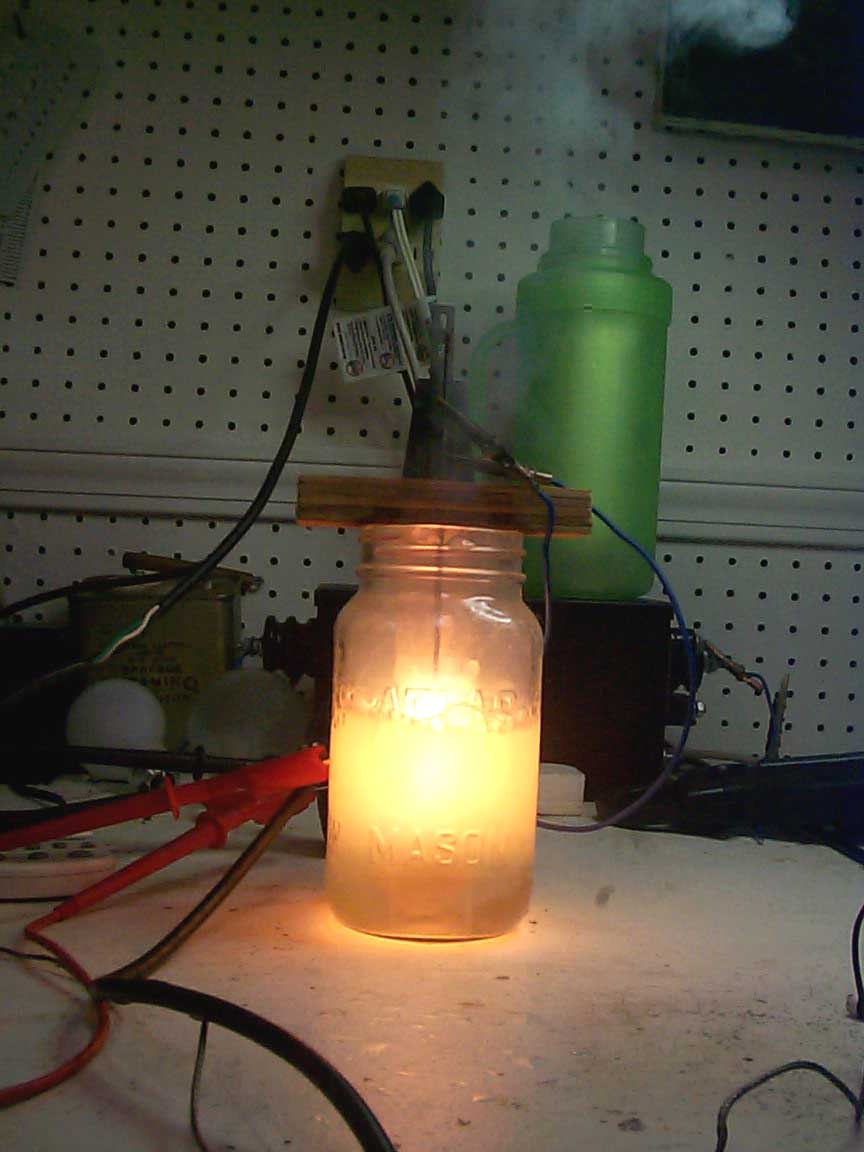
| |||||||||||
Hi All,
I ran my CFR #1 this morning at around 0.6
KW. All I can say is be careful. The amount of steam is
amazing, the action of the water is just a little short of an explosion.
It definitely gets your attention.
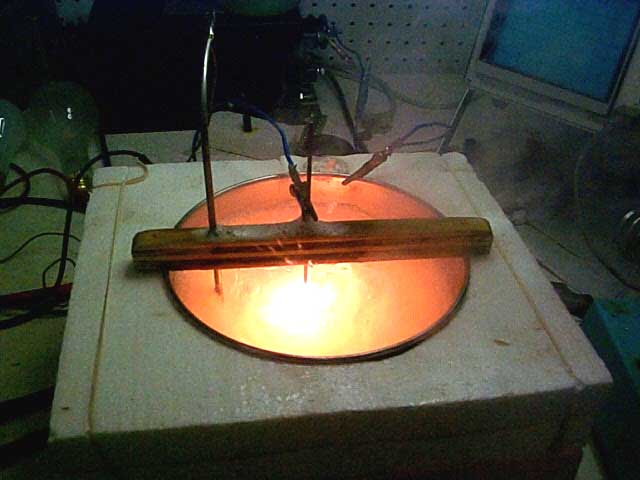
Started with 1000 ml of distilled water. 0.2 mol potassium
Carbonate.
Starting water temp 85C.
Voltage 320 VDC aproximately from a
standard X2 voltage doubler of 2-40 amp diodes and 2 1000uf caps directly from
120 V RMS house line.
I would give my right arm for a good 2KW Variac
right now, but its in the mail and experimentation must go on.
Again, just brute force electronics.
5 Min
run.
It took about 20 seconds to get the 1000 ml on up to
operating temp (97C) from the 85C to where pure plasma was being made.
When this happened, it was hold onto your hat with the water and steam
flying. I'll have to clean up my whole workbench after this run.
Total water to steam was about 320 grams in that 5 min with
another 40 grams of water wiped up (estimated)(weighed the paper towell before
and after wipe up!. Current was estimated around 2 Amps as the RF and EMI
just blasted through my filter network.
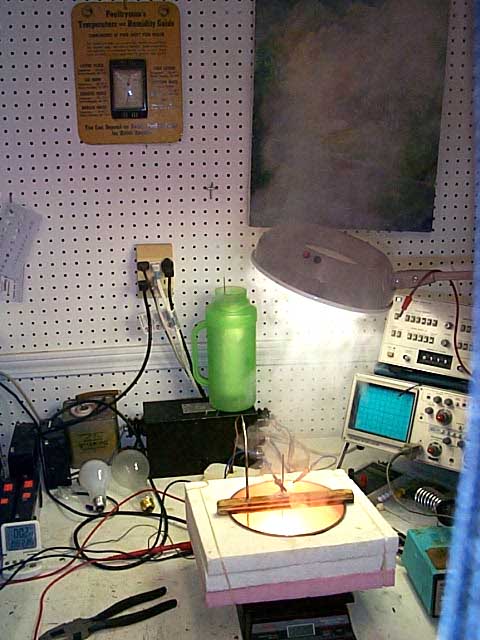
I'll let those that can calculate the COP. All I'll say is JLN is correct, voltage is everything. It would appear to be around 3.5 but I won't swear to that as instrumentation is not there right now, at least not that I can trust. I have more engineering to do both mechanically and electronically.
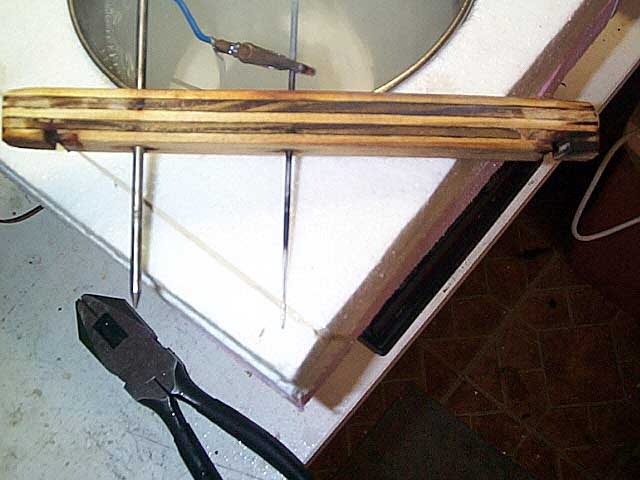
I had sever erosion of the cathode electrode and as JLN has mentioned, my SS
pan might be messing up my E field and causing this.
My next run will be
in a Pyrex glass to see if there is a difference.
The above is very slopy
science but the difference between 194 VDC and 340 VDC is as night is to
day!
Yes, there is pictures on my website at:
http://www.geocities.com/k4zep/606.htm
Ben
| |||||||||||
Hi
OU with 630 volts pulsed DC.
I started the run at 50
degrees, and ended up with 85 degrees. I tried to give just the right pressure
on the switch connection so it would be between 100-200 watts.
The
electrical input was 0.04 kWh, and I steamed of about 40 grams of water.
Power out = (370*4,18*35) + (40*2260) = 144531J
Power in = 0.04 *3600*1000
= 144000J
COP = power out / power in = 144531
/ 144000 > 1
Then if we also take into consideration
the at the power supply has a 10 ohm resistor in series with the CFR, and the
pulses are maybe more the 10-15 Ampers, more then 100-150 volts will be over
this resistor and less then 500 volts will be over the CFR.
This taken
into account the COP jumps till 1.3
The mechanical switch is getting real
hot, so it to is wasting some power, so then the COP
might be closer to 1.4.
This was a run from 50 degrees,
and most of the COP should be from the run with the warmer water, so what the
COP was when the bath was above 80 degrees, is left open for
speculation.
My conclusion is that this looks
promising.
Regards
Svein
_________________________________________________
Dear Naudin
I am just using a mecanical swith at the moment, but I
think it will
be OK to use electronics too.
If you look at:

I only used part of this. Two diodes, and the U+ till U- with two capacitors
in between. Each rated for 385v, so it can hold the 630volt I am
getting.
The larger the capacitors, the more current you can run through
it.
I use a total of 6X220uF so this will be like 3*220uF/2 =
330uF
If we stick to 1000uF per Amper, this should be good for 0.3
ampere. With 1% duty cycle it will manage 0.3/0.01=30 ampere. So my 10-15 ampers
pulses should be OK.
Regards
Svein
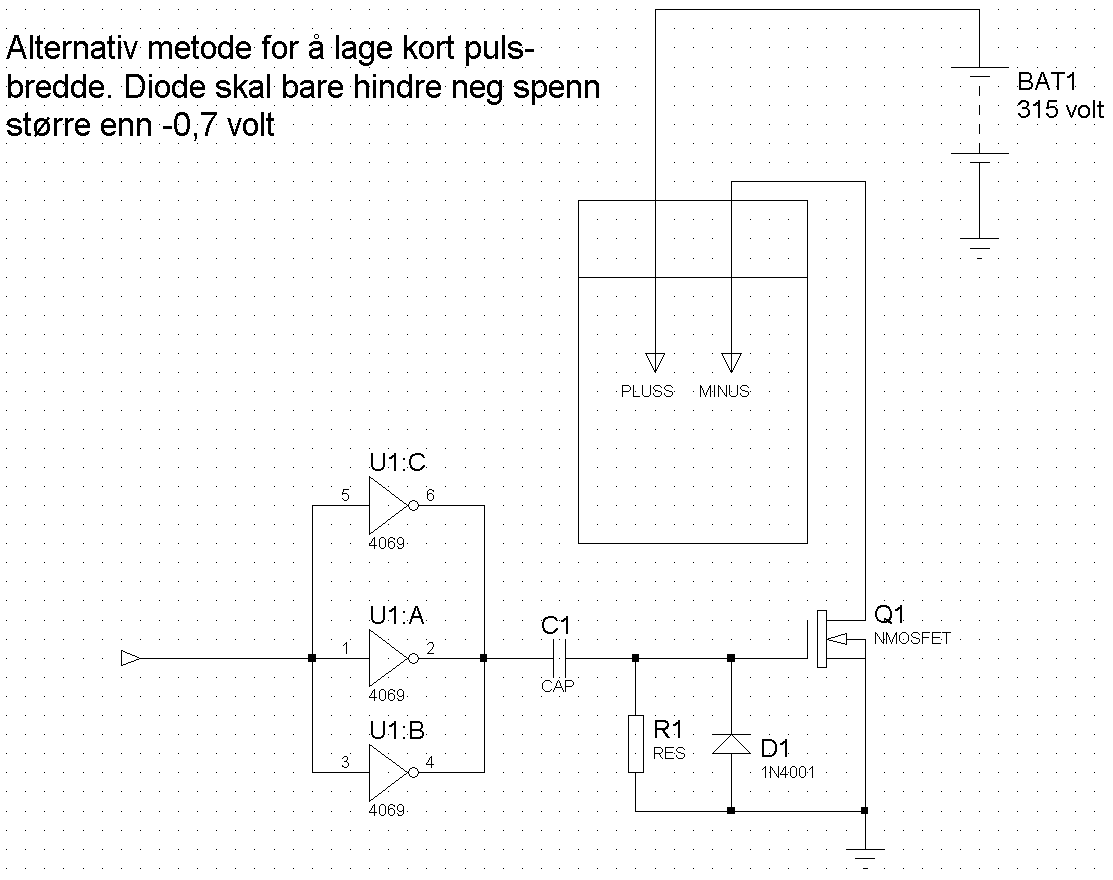
| |||||||||||
Hello Jean-Louis,
Thanks for publicizing this, and so many other,
world-changing discoveries!
I have some CFR Photos for you, and some
results that might be of interest to prospective experimentors. The other
results might seem obvious, but I though I would write them down to save others
the trouble of re-creating them.
First, my duplication of the reaction,
using BakingSoda, stainless steel Anode, 3/16" Tungsten 2%Th cathode:
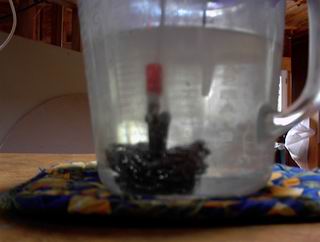
Electrolysis
visible at 10V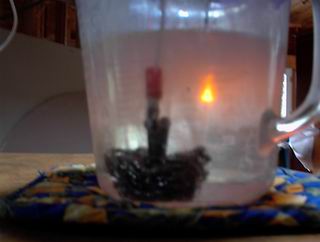
Sodium
colored arc begins around 90VDC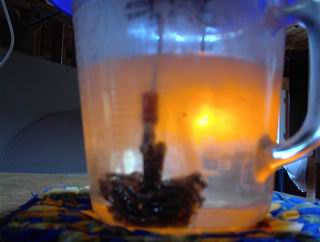
Strong
arcing at 130VDC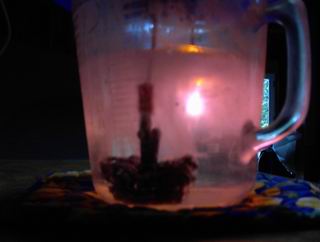
Clear color
change as Plasma forms
and Tungsten Incandesces at 150VDC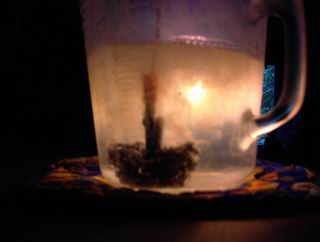
'Full Steam' at 200V
Now, for some interesting data:
First, using pure water
results in only slow electrolysis even at 270VDC. (as you would
expect.)
Second, using cooler electrolyte resulted in blowing my 10A fuse
before plasma formed.
And third, most interesting, substituting a copper
cathod for the tungsten gave these results:
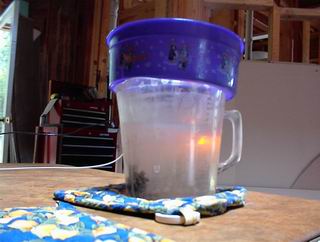
Similar Arc
forms at 100VDC,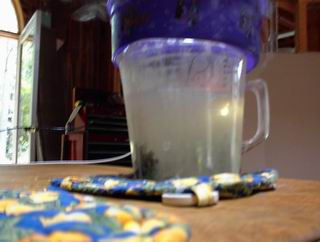
Followed by
plasma formation at 160V,
With a strongly GREEN color to the emitted
light.
But the plasma cannot form as fully using the copper electrod
because: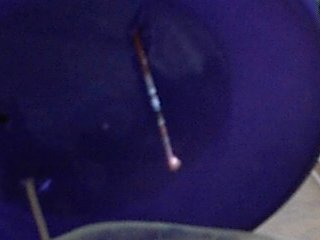
The
copper electrode quickly melts and dissappears.
This 14ga copper wire melted
up to the surface of the electrolyte after
only 5-10 seconds of plasma
reaction.
Here is a photo of the electrodes from my CFR.
At left, an
unused 3/32" W-2%Th Electrode.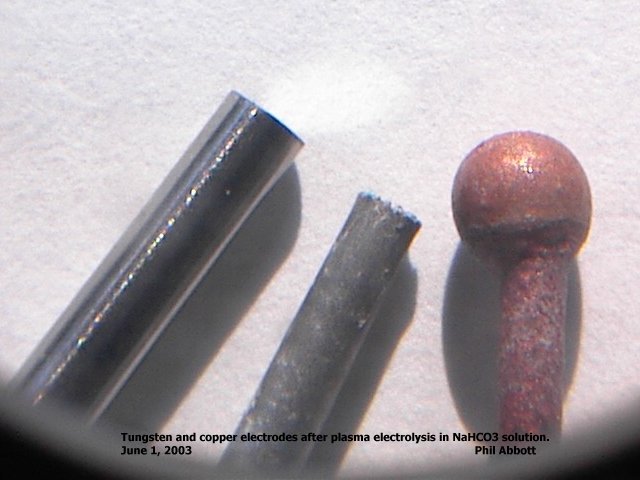
Center, same
type electrode after about (6) 30-sec reactions.
Close examination shows
significant cratering on the bottom surface,and something that looks like copper
chloride crystals (although this electrode was only used before the copper
test). The craters appear to be be about 1/10th the diameter of the rod,
and nearly hemispherical in profile. At right, a piece of 14ga. copper
wire after 10 sec as a cathode. Significant cratering and discoloration along
the length, which was near the surface of the electrolyte, and the surface of
the ball of melted copper looks like an asteroid on close examination. They have
the look of small explosions occuring on nearly molten metal. Also note the
reduction in diameter of the Tungsten electrode. The electrolyte acquired a
green tint after the Copper experiment.
Next step, I have gathered equipment to try the reaction in a
pressurized vessel,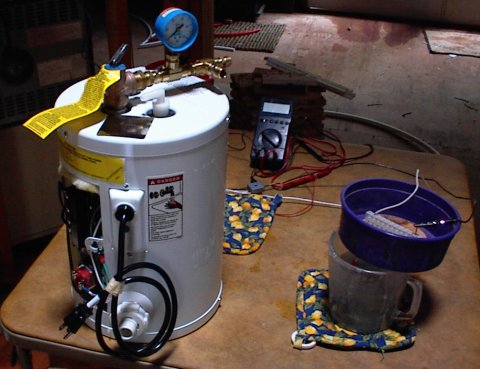
But I am a bit worried about what the possible reaction products
might be. Clearly we have steam, hydrogen, oxygen, but the colored arcs which
vary with the electrode material indicate that chemical reactions are occuring,
and that coupled with evidence of transmutation in the electrodes, and probable
fusion reactions of unknown character, indicate that we really have very little
idea of what kinds of compounds or radiation might be generated in this
seemingly simple process. Although reports are that no radiation or
radioactive by-products have been encountered, these are serious hazards and we
need to be sure before exposing outselves for extended periods.
Some caution
is in order while the reaction is studied, since it is possible that hazardous
products may be generated from these inert ingredients!
Good luck and
Please Use Caution!
Phil Abbott
Wake Forest/
Research Triangle
Park
North Carolina, USA
| |||||||||||
CFR 4.0 - To make a more stable reactor!
216 ml of fuel/hr, 18.25V at 4.78 amps 208
F/97.75C
135.6 watts out/87.23 watts = COP 1.554
Pictures below will show basic unit. I have extensive data but will take hours to put into Excel and show plots. I will say it is amazing the difference in the amount of steam produced with 1 degree change in the reactor.
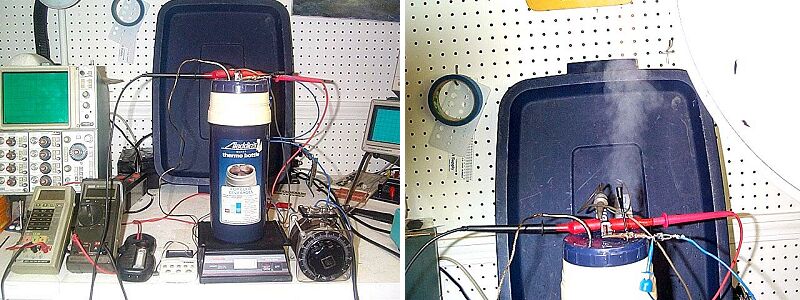
The final picture at end of 1-hour test run, blowing steam like a champ.
That’s it.
Ben
Full details of this test at : http://www.geocities.com/k4zep/527.htm
| ||||||||||||
Here are 2 new pictures and 1 new video of my CFR experiments.
http://groups.yahoo.com/group/free-energy/files/cold_fusion/
I just tried to
use 2 stainless steel meshes as the electrodes and that also works quite
nice.
The main reason to get these arcs unter water is the K2CO3. With it
the reaction is very violent and the arcs form. If you are just using only tap
water, it is very hard to get arcs at all !
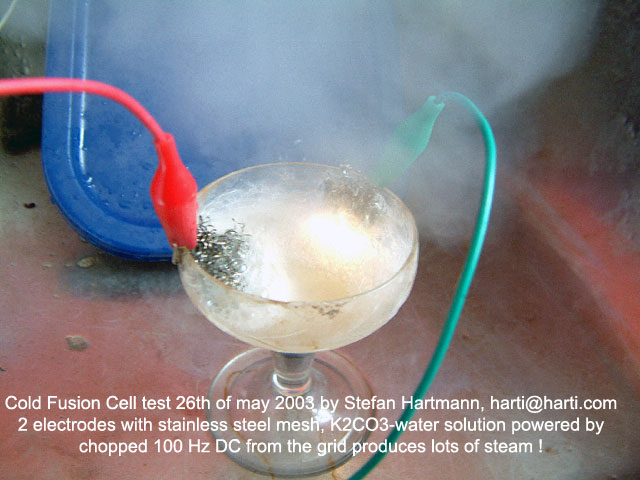
You can see in the second pic, that if the arc is forming at the cathode
mesh, almost all steam is generated at the anode !
This is also true, if
there is no arcing !
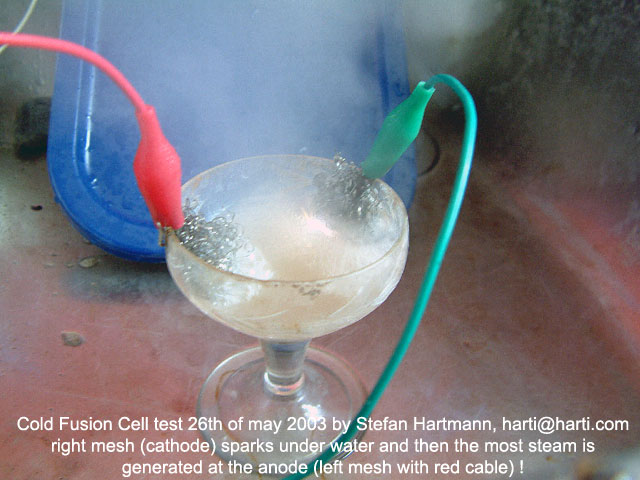
Over 80 degrees Celsius, almost all steam is generated at the anode
!
My 2nd try this , which is documented in the wmv video, was a cell,
that was powered by pure 230 Volts AC directly from the grid.
At both
tungsten rods you can see the arcs unter the water,so AC also works quite nice
!
It also depends on how much K2CO3 you put into the water !
Regards,
Stefan.
P.S.: I first have to get a good digital scale and some power
measuring equipment to do quantitative measurements, so in this moment I can´t
say much about efficiencies, but the steam production is pretty big
!
----
Dipl. Ing. Stefan Hartmann
Hartmann Multimedia Service
www.harti.com
Keplerstr. 11 B, 10589 Berlin, Germany
| |||||||||
| Envoyé via Internet | |||||||||
Hi JL,
Here are 2 jpgG pics, which show the violent reaction, when a Tungsten rod burns water, when it is stuck about 5 mm deep into the surface of the water and 100 Hz chopped DC from a bridge rectifier from the grid (230 Volts 50 Hz AC converted to 100 Hz rectified chopped DC without a capacitor) )is applied to it. The water solution contained some K2CO3. Anode mesh was stainless steel mesh. When some water was burnt away to steam, so the rod was not touching anymore the water and the current stopped, the 2nd pic shows the red glowing tungsten rod just over the surface of the water just the moment, when the reaction stopped.
Thanks again for working so hard and publishing all your datas on your web pages. It really is a hard work to do this all.
Thanks again ! You will be remembered in history. I wish I had more time to do more experiments !
Regards, Stefan.
----
Dipl. Ing. Stefan Hartmann
Hartmann Multimedia
Service www.harti.com
Keplerstr. 11 B, 10589 Berlin, Germany

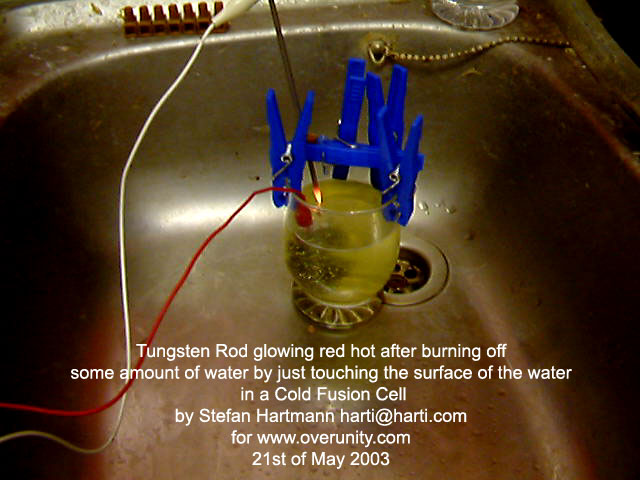
| |||||||||||
Hi Jean-Louis,
Just some news. Thanks VERY MUCH for the
info on how to make the mixture correct.
I have ran a 30 min test using
the original liquid. 1000 ml 1.25 Tsp. of soda. I'll do it next time with the
correct mixture.
50V RMS @3Amps or 150 Watts. (1/2 wave via simple diode,
no filter,pulsed 60Hz via Variac adjustable)
30 Min run time.
Starting
amount of liquid, 1000ml Put 1000 in, measured at end of test.
Ending amount
of liquid, 775ml!! LIQUID CONVERTED TO STEAM 225 ml !!!
Now to get all to
1 hour, we change to 450ml / hour which would be 2260 X 450 = 1,017,000 Joules
divided by 3600 seconds = 282.5 watt/hour. 50V average @ 3 amps = 150 watt-hours
resulting in 282.5/150 = COP of 1.883 which is
pretty darn good for this rinkey-dinkie system. I do not know how to calculate
the energy required to keep the liquid at 185 degrees in that Stainless Steel
pan etc. But that has to be conservative as heck. That fluid loss blew me away!
Oh there was no steam when heating it up to 180 degrees with the stove. The darn
thing just sits there and cooks and is stable as heck. If I could adjust the rod
to keep the current constant it would be nice, but with the 1000ml bowl, it only
drops 10% over a half hour.
Mixture was brought to 180 degrees with
stove, stove turned off, then current adjusted to 3 amps. Current/voltage
required adjustment over the 30 min as liquid level was falling in container.
Started off at 43 V @ 3 amps, ended up at 50 V@ 3 amps, or in other words, I
tried to keep the current steady. With this in mind, and the loss in heat in the
un-insulated bowel the numbers above are VERY conservative!
Things of
note.
1. There is a BROAD BAND emission of RF from the device. At 1.6 MHZ
on a portable radio, it is an extremely strong static. At 108 MHZ FM, there is
popping and cracking like you hear from the the Geiger counter with background
radiation. Oh, there is NO increase in background radiation (Beta) on the Geiger
counter.
2. The temperature remained constant at about 185 degrees from
its own heat generated.
3. Wire leads to Cathode while #22 are flat out
cold (must really measure this). Small wires from variac to diode bridge #22
also are very warm to the touch, but after the diode, cold????? Do NOT ask me
why?
4. There is some small bubbles coming from the anode but the mixture
does NOT burn.
Still having fun
To free stuff
Ben
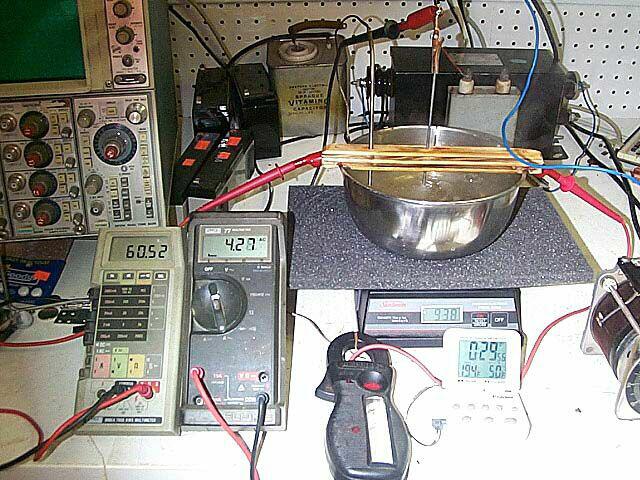
| |||||||||||
Hi,
I have made today also some new experiments:
1. I wanted to test,
if the anode has the same violence arcing under water as the cathode, so I
exchanged the polarity. I used tungsten rods as both electrodes ... and stuck
just one electrode just 0.5 cm under the water-K2CO3 solution.
Result: No,
there is only minor buildup of steam at the anode, but nothing else.
So
it rules to use the cathode (minus pole) to use the arcing under water
reaction.
2. As I did blow up several times my 1N4007 diodes of my
rectifier bridge (okay they are also just rated at 1000 Volts at 1 Amp; I still
have to buy a high amperes bridge), just use 3 or 4 diodes in parallel for each
leg of the bridge...(okay, you should use also a resistor in series but I didn´t
had any 1 Ohm high power resistors...) Anyway, now I don´t blow anymore the
bridge, it seems to work.
3. The initial current into the solution
depends mainly on how much you stick the cathode into the solution !
The
anode can be stuck through the whole length into the water-solution, it does not
matter how deep it goes.
I tested it today with the cathode about 1,5 cm
deep into the solution and the initial current was about 1,3 Amperes at about
max 325 Volts peek chopped 100 Hz DC from the rectifier bridge.
Now that
was about at 70 degrees Celsius temperature. Now after some seconds first there
is huge bubbling at the cathode of hydrogen and then suddenly the arcing occurs
and the whole 1,5 cm immersed cathode begins to violently glow and steams off
water. Now then the current went down to about 0.7 Amperes, when the arcing
takes place.
That is in good comparison with JL Naudin´s results. Also his
current decreases.
4. I then tested 2 cathode rods powered in parallel
and also this works ! Both rods begin to arc under water and the current even
went down more, to about 0.6 Amperes ! So it seems to matter how much surface
you have as the cathode under water and how many arcs are burning under water.
To obtain the exact input power into my cell is still a bit difficult,
cause I don´t have the right measurement equipment in this moment.
I hope
this helps.
Try it yourself, it is pretty easy.
Regards,
Stefan.
----
Dipl. Ing. Stefan Hartmann
Hartmann Multimedia
Service www.harti.com
Keplerstr. 11 B, 10589 Berlin, Germany
| |||||||||||
Hi Jean Louis,
congratulations to your recent Cold Fusion success.
I am
currently also experimenting with it and if you want you can put my videos
onto your web pages.
They are
here:
http://groups.yahoo.com/group/free-energy/files/
Look for the
waterburning_cell*.wmv videos.
You need Windows Media Player Codecs 9 to view
them. Mediaplayer 7 will automatically download the codecs.
Hope you enjoy
them and keep up the good work.
Regards, Stefan.


| |||||||||||
Dear all
Result from my new test with K2CO3. This time I used much
less K2CO3.
About 10 grams in stead of 150 grams as I used in my earlier
run.
After several runs I get about the same result.
I use a 2 litre
plastic can with 1.5 litre of water.
10 grams of K2CO3 and 220AC rectified.
(About 280 volts).
Water started at 80 degrees and stopped at 96 degrees.
Steamed of 15 grams of water.
ENERGY OUTPUT = ( 15 x 2260 ) + ( 1500 x 16
x 4.18 ) = 134 k Joules
Electrical input = 0.03*3600*1000= 108 k
Joules
Energy OUTPUT/INPUT = 134 / 108
= 1.24
The power in
was measured with a PM-300 from W.H.Mondolyn International Ltd.
I do not know
how well it will measure energy consumption when the power is fluctuation from
almost zero till more then 650 watts.
COP = 1.24 might me more correct
then the test I did on 17th of May with 150 grams of K2CO3. This resulted in
strong light and a meltdown of the tungsten rod, and the caps did not like this
so one exploded.
The COP I measured that day was most likely very wrong, so
the test that resulted in a COP=1.24 is made under more controlled
conditions.
Regards
Svein
| |||||||||
| Envoyé via Internet | |||||||||
Dear Naudin,
Thank you very much for your interest in my CFR and my pictures.
I do not have as nice pictures as you use to present, but I think the picture I got of the tungsten electrode after the run is good. If you will use any of this on your web, you are free to do so.
The tungsten rod was like a cylinder before I turned on the electricity, but after 10 minutes it was more sharply pointed at the end that was submersed in water. You can also clearly see the many small cracks in the rod.
I used 1.8 litre of water and 100 gram of NaHCO3. After 10 min. 100 gram of water was boiled off. What I notice is that it can consume more then 16 amp. the first seconds, then when it starts to glow white, the current will go down.
My fuses will only take 16 amp, so I need to start it with only one cm of the rod in the water, and when it is glowing, I can push it further down into the water.
Regards
Svein
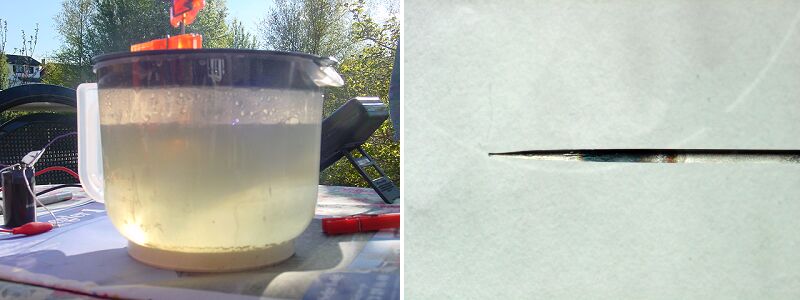
Return to the CFR Experimenter's corners
page
